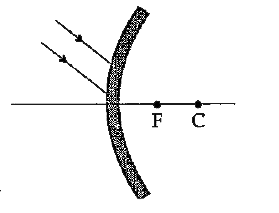Complete the ray diagram shown in fig to show the formation of image for parallel rays incident on a concave mirro. State position, nature and size of the image formed.

The completed ray diagram is showin in fig. The image is formed at the focus F. It is real, inverted and diminished.

Topper's Solved these Questions
- REFLECTION OF LIGHTBOOK - ICSECHAPTER - REFLECTION OF LIGHTEXERCISE - EXERCISE 7(A)
28 Videos
- REFLECTION OF LIGHTBOOK - ICSECHAPTER - REFLECTION OF LIGHTEXERCISE - EXERCISE 7(B)
9 Videos
- PROPAGATION OF SOUND WAVES BOOK - ICSECHAPTER - PROPAGATION OF SOUND WAVES EXERCISE - EXERCISE -8(B) (Multiple choice type)
3 Videos
- SOUNDBOOK - ICSECHAPTER - SOUNDEXERCISE - TOPIC 2 Infrasonic and Ultrasonic Waves ( 3 Marks Questions)
3 Videos
Similar Questions
Complete the ray diagram as shown to show the formation of image for parallel rays incident on a convex mirror. State the position, nature and size of the image formed.

View Solution
Copy and complete the ray diagram to show the formation of the image of the object AB
View Solution(a) To construct a ray diagram we use two light rays which are so chosen that it is easy to know their directions after reflection. Use these two rays to locate the image of an object placed between infinity and the centre of curvature of a concave mirror.
(b) Draw a ray diagram to show the formation of image of an object placed between the pole and principal focus of a concave mirror. How will the nature and size of the image formed change, if the mirror is replaced by a converging lens of same focal length?
View SolutionDraw ray diagram to show formation of magnified real image of an object by a concave mirror.
View SolutionDraw ray diagram to show formation of magnified virtual image of an object by a concave mirror.
View Solution(i) Rohit claims to have obtained an image twice the size of object with a concave lens. Is he correct? Give reason for your answer.
(ii) Where should an object be placed in case of a convex lens to form an image of same size as of the object? Show with the help of ray diagram the position and the nature of the image formed.
(iii) With teh help of ray diagram, illustrate the change in position, nature and size of the image formed if the convex lens in case of (ii) is replaced by concave lens of same focal length.
View SolutionDraw neat and well labelled ray diagrams for image formation by a convex lens when an object is at infinity.
Also state the position , nature and size of the image relative to that of the object.
View SolutionDraw ray diagrams to show the formation of images when an object is brought closer to concave mirror, from infinity.
View SolutionDraw ray diagrams showing the image formation by a concave lens when an object is placed
(a) between focus and twice the focal length of the lens
(b) beyond twice the focal length of the lens
View SolutionDraw a ray diagram to show the formation of image by a concave mirror for an object beyond its centre of curvature. State three characteristics of the image.
View Solution
